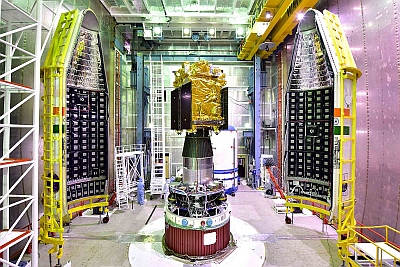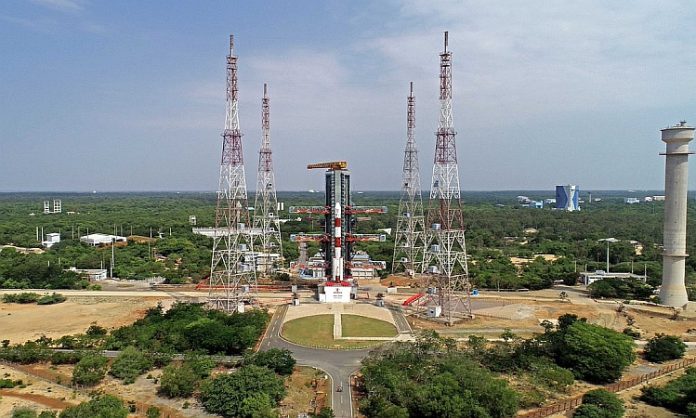Bengaluru: The Indian Space Research Organisation (ISRO) has triggered the countdown for much-awaited launch of India’s maiden solar mission, Aditya-L1 onboard the PSLV-C57 rocket. The spacecraft is scheduled to take off at 11.50 am on Saturday.
The solar mission is being launched close on the heels of success of successful moon expedition, Chandrayaan-3. Aditya-L1 is designed for providing remote observations of the solar corona and in situ observations of the solar wind at L1 (Sun-Earth Lagrangian point), which is about 1.5 million kilometres from the earth.
Also Read: Aditya-L1 is not a complete mission to study the Sun, says ISRO
According to the ISRO, the Aditya-L1 mission aims to study the Sun from an orbit around the L1 with the help of its payloads to observe the photosphere, chromosphere and the corona—the outermost layers of the Sun—in different wavebands. “Aditya-L1 is a fully indigenous effort with the participation of national institutions,” said an ISRO official.
Why do we need to study Sun?
Professor and in-charge scientist at the Indian Institute of Astrophysics (IIA), R Ramesh  said that just as there are earthquakes on Earth, there are something called solar quakes-called as Coronal Mass Ejections (CMEs)-on the surface of the Sun. “In this process, millions and millions of tons of solar materials are thrown into the interplanetary space. These CMEs can travel at a speed of approximately 3,000 km per second. Some of the CMEs can also be directed towards the Earth. The fastest CME can reach near Earth space in approximately 15 hours,” Ramesh explained.
said that just as there are earthquakes on Earth, there are something called solar quakes-called as Coronal Mass Ejections (CMEs)-on the surface of the Sun. “In this process, millions and millions of tons of solar materials are thrown into the interplanetary space. These CMEs can travel at a speed of approximately 3,000 km per second. Some of the CMEs can also be directed towards the Earth. The fastest CME can reach near Earth space in approximately 15 hours,” Ramesh explained.
Also Read: After Chandrayaan-3, ISRO set to launch solar probe next week
Is Aditya-L1 different from other similar missions?
Ramesh said that the India’s maiden solar expedition is different from those launched by other agencies like the European Space Agency (ESA) and NASA (National Aeronautics and Space Administration). “Both the agencies have launched similar missions in the past, the Aditya LI mission will be unique in two main aspects because we will be able to observe the solar corona from the place where it almost starts. Also we’ll be able to observe the magnetic field changes in the solar atmosphere, which are the cause for coronal mass ejections or solar quakes,” added the scientist.
CMEs, emitted from Sun can damage artificial satellite
The CMEs originating from the Sun can damage satellites by engulfing them. Due to the discharged particle flow from the CMEs, all the electronics onboard satellites can malfunction. In 1989, for instance, when there was a massive eruption of the solar atmosphere, Quebec in Canada went without power for about 72 hours. The Zurich airport in Switzerland was affected because of CME for almost 14 to 15 hours in in 2017.
Also Read: Chandrayaan-3’s lander reaches Moon surface, Isro creates history
Explaining the impact of CMEs, Ramesh said once the CMEs reach the Earth, which is like a big magnet with north and south poles, they can travel along the magnetic field lines and then they can alter the Earth’s geomagnetic field. Once the geomagnetic field is affected, it can impact the high voltage transformers.
“So, it is very important to put a centre of observation to continuously monitor the Sun, which is possible from the Lagrangian (L1) point, he pointed out. India is launching the Aditya-L1 to place its satellite at Langrangian-1 point.”
Why do we need to study Sun from space?
The Bengaluru-based IIA has a long tradition of almost close to 125 years of observing the Sun on 24×7 basis. “Though observations of the Sun can be carried out with a ground-based telescope, they have two major limitations. One is that there are only eight or nine hours available in a day to monitor the sun since such observations can be carried out only during day time and not at night.
Also Read: ISRO readies for Chandrayaan-3 landing; people seek divine blessing
The second challenge while monitoring the Sun from Earth is that the light coming from the sun will be scattered by the dust particles in the atmosphere. As a result the image can get blurred, he explained. The IIA felt the need to have a telescope in space for 24-hour uninterrupted observations of the Sun,” added Ramesh.
Lagrangian Points
There are five vantage points from where the Sun can be monitored. These are called the Lagrangian points, which are named after an Italian astronomer Joseph-Louis Lagrange who discovered them. The gravitational force of attraction between the Sun and the Earth at the Lagrange points are perfectly balanced, the scientist said.
Also Read: Russia’s lunar spacecraft, Luna-25, crashed on Moon’s surface
Of all these five points, there is a point called L1 to have an uninterrupted view of the Sun. This point is located between the Sun and Earth at a distance of 1.5 million km from the Earth. The Aditya L1 space mission will take 100-plus days to reach the Lagrangian-1 point. Data from this satellite will be downloaded at ISOR’s Indian Deep Space Network near Byalalu on the outskirts of Bengaluru and will be transmitted by a dedicated internet link to the Payload Operations Centre of the IIA. The data will be processed and sent back to ISRO for dissemination to the general public as well as for use by the scientific community.




